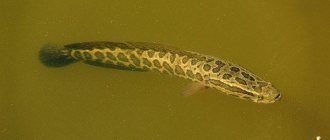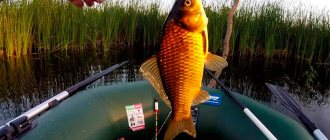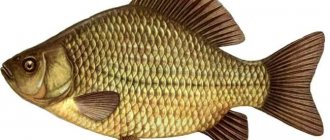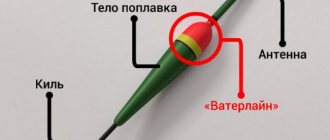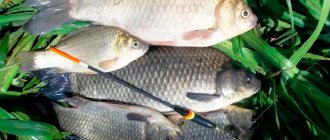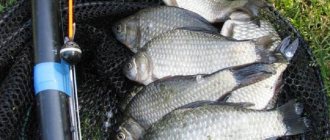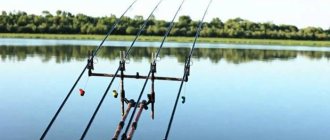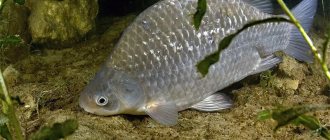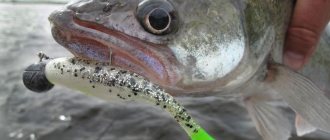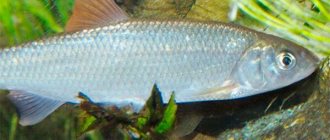In all corners of our country, crucian carp regularly go on strike, but even in the utter lack of bite, fishermen are not offended by this sly man - taking at least one tail, they say: “I still love you - how nice it is to hug a silver bar with your palm, and with two hands it’s even better! » A huge amount of experience in “diplomatic relations” with crucian carp has been accumulated throughout the country - on many local lakes this is the main fish that they love, respect, and know how to catch with both a fishing rod and a donkey.
In many regions, crucian carp is found everywhere, from the most musty swamps to rivers with oxbow lakes and creeks, and everywhere it is different, which means the fishing is different. In one reservoir, crucian carp (of decent size) bite for a couple of weeks a year, the rest of the time they kill small things, in another only in winter, in a third in autumn, and so on endlessly. The character of crucian carp is sometimes like that of a capricious young lady - she wants something sweet, now sour, now salty. Today he rushes around the lake and grabs everything you offer, just like an overfed soldier - demobilization in the kitchen. And when it does bite, you need to be a seer or have enormous fishing experience to guess that in the morning the crucian carp will bite on a worm, from ten on bread, from noon on maggot, and by the evening reject everything, preferring a sandwich of maggot plus pearl barley.
With a brace! Experiment and experiment again!
One day in the evening we arrived at one lake, where there were tons of crucian carp, full of hope and impatience, we fed several points, cleaned places here and there, and went fishing. But it was already approaching seven in the evening, and he did not show up at all, only at sunset he sluggishly pecked for half an hour. What's the matter? The pressure is excellent, the weather is correspondingly beautiful, the moon is in the right phase, especially for us, but it’s not biting and that’s it.
To minimize the consequences of the disgusting bite, they covered the clearing with all that entails. One of the comrades, the most stubborn one, remained on the shore staring at the float fireflies. Suddenly, in the dark, the crucian carp's appetite will return, then there will be general alarm and a general gathering at the gear. We sit, talk, complain to each other about the scoundrel crucian carp, smell the smoke from the fire and console ourselves with hopes for the morning. And then the foggy morning came, we moved to our workplaces. Two hours pass, three, and the sun is already warming with might and main. But where's the bite? At breakfast we came to the conclusion that this time it was a complete bummer. But you shouldn’t leave right away without a quick slurp? – paws are not trained to lift up. And how to attract his infection, we tried everything, well, maybe we didn’t use the subtle aroma of unwashed socks and raccoon skunk droppings.
At about eleven o'clock, out of complete hopelessness and bored inaction, I decided to drag the float 15-20 centimeters - immediately there was a cautious but distinct bite. Yes, my dear is sitting. Behind him are five more fine brothers. I run to my people, tell them the password to access the crucian carp for today, and it’s off. Until one o'clock in the afternoon we had a good catch. And if it weren’t for this little touch on the topic (although each of us experimented with depths, places, nozzles), then nothing good would have come of it.
Conclusion: fishing for crucian carp, like no other, requires room for a creative approach to this amazing picky fish . In difficult cases, you need to use all the fishing tricks in order to provoke and activate the inactive fish.
Catching crucian carp with a feeder
Have you ever seen kilogram crucian carp walking in shallow water at depths of 30-50 cm?! The impression is as if you are at a nuclear submarine base - humps stick out above the water, whirlpools, a sight not for the faint of heart. All events take place 15-20 meters from you. What to do?
I take a light feeder for fishing and throw it there to them. Although the feeder is miniature, it splashes noticeably, and these guys immediately calm down. You think you've scared the day away! But no, after about ten minutes the fish’s movement resumes, as if sideways, but towards the food, I’m all ears, and here it is, the pull, hurray, the hook has taken place! While the crucian carp is knocked down, you drag it a few meters, and then it comes to its senses, turns on the engine and rushes to the side, usually into the grass or reeds. It is not difficult to guess how events will develop further. Running along the shore with advisers, frantic attempts to bring the fish out of the tents, putting on a wading suit, quickly moving towards a meeting with the long-awaited trophy, but you fall into the silt up to your chest, in the end, after many attempts, you find yourself at the place of the appointed meeting, but the client has left! And such feelings are overwhelming, words cannot describe them!
My opinion is that the most difficult way to catch crucian carp is with hooks and the like. gear, because its reactivity is known, and at the highest gear ratios on the reel it turns out to be more agile. Because of this, I rarely use hooks in the summer, although it’s not for everyone, many people only catch fish with hooks.
Feeder fishing for crucian carp - universal feeder tackle!
On tightening
The weather itself can dictate the best way to catch crucian carp. So, in a gusty wind, ripples are driven across the water. At this time (especially after hot days) it makes sense to try fishing on clean runs in the retrieve - the line pulls the float in an arc, the load can drag along the bottom, or only the hook can touch the ground; sometimes, especially along the algae, it generally takes well in half-water. Bites during such fishing are usually confident and, which rarely happens with crucian carp, you can successfully catch from one place all day, it does not get tired of fishing attention.
One maggot is good, but half a maggot is excellent!
Experiments and more experiments lead to successful crucian fishing. It would seem, what else can you come up with with such an attachment as the well-known maggot. Closer to autumn, with the first cold snaps, when the crucian carp's basic reflexes are slowed down, and in general, when the bite is bad, I pinch a couple of maggots on the hook. Sometimes I go even further - I cut off half the larvae with sharp scissors, and sometimes this is the only thing that revives the bite.
The main principle of crucian carp
- home
- Archive
- Nizhny Novgorod fisherman
- The main principle of crucian carp
Alexey Bykov
A series of quiet spring evenings could not leave me indifferent. "Fishing!!!" – this thought stuck firmly in my head and gave me no rest. Circumstances were such that dreams of long trips had to be put aside. Therefore, my choice fell on the nearby quarry.
Quarry is too strong a word, this puddle (which has long served me faithfully as a kind of training ground for exercises with a float rod) is only about thirty meters long, and even less wide. In addition to the function of housing for a variety of fish, the quarry also bears the responsibility of a fire reservoir.
In our village near the Volga region there are several such reservoirs, but this is exactly what I have long been attached to. The fact is that it differs from its other brothers by the presence of different fish. If crucian carp and rotan are caught everywhere as a standard, then small bee-eaters, large loaches, and young tench periodically appear here.
There is a suspicion that one of the local fishermen, as a hobby, is specially experimenting with the acclimatization of living creatures that are not standard for this puddle. Well, I’m not against such surprises, especially since I myself am content mainly with crucian carp and have almost no claims for other fish.
Crucian carp, as you know, comes in silver and gold. I don’t meet the gold one often, for some reason this beautiful fish doesn’t like my gear, but the silver one sometimes shows loyalty to my gear.
Unfortunately, there are no truly large crucian carp in the reservoir, but there are plenty of small ones. There are, of course, individuals up to half a kilogram, but these are, rather, exceptions, because the majority of pecking crucians are the size of a finger. In general, a typical “cat” size.
I’m sure many will say that it’s amazing to catch small things. But I assure you, you shouldn’t make hasty conclusions. Not everything is as simple as it might seem at first glance.
Firstly, I’m not left without normal fish – three-hundred-gram plump crucian carp “as big as a palm” – even though they don’t “slip through” often.
Secondly, such fishing is not boring at all; it brings a lot of positive emotions.
Thirdly, the cat is quite pleased with the result of the fishing. Again, for pike, small crucian carp as bait is like chocolate for a sweet tooth.
In general, for several years in a row I have been happily practicing catching crucian carp in a neighboring quarry. And, oddly enough, I am discovering more and more subtleties of crucian carp fishing.
Precisely subtleties, since the one-gram float equipment with which I first came ashore now only makes me smile at my own naivety. I think it’s not worth going into the history of the transformation of my gear; it’s easier and more useful to describe what I’ve slowly come to.
I won’t go into detail about the rod – everything here is extremely simple. An ordinary telescopic rod 4-5 m long, in my opinion, copes with its task ideally, because the fishing distance is short, especially since the bait dictates my conditions to the fish.
Catching crucian carp without bait is, as a rule, a thankless task, but there is practically nothing to describe in detail here. I tried a lot of baits, but did not reveal any significant differences. For crucian carp, any ready-made mixture for carp works for me, as long as it is fresh. I knead it on the spot, soaking it with water from the quarry until it becomes thick sour cream. I feed only once, once. It is necessary to supplement feeding very rarely. I throw the bait by hand. In general, nothing unusual.
But I’ll tell you more about the equipment of the fishing rod. There is some “know-how” here.
First of all, the fishing line. The main material is fluorocarbon 0.14 mm. Why him? Yes, because if you lower the tip of the rod to the water, fluorocarbon sinks and, accordingly, allows you to partially get rid of the influence of surface currents when they interfere. But they don’t always interfere; often crucian carp prefer bait slowly drifting over the bait. In this case, by changing the location of the rod tip relative to the water and the feeding location, it is possible to control and sometimes artificially create movement even in complete calm.
The invisibility of fluorocarbon is, although a useful property, but for me it is not important in this fishing. Therefore, you can get by with any normal sinking fishing line marked Sinking.
The float is a goose feather. I can imagine the bewilderment this caused among advanced floaters. Yes, exactly the good old goose feather... but not the whole thing, but only the thin outer part, without any air cavities.
In my case, the load is only 0.1 g, i.e. one small pellet. To make loading easier, I first clamp the pellet and then use a knife to cut off the excess part of the feather. The feather is attached to the fishing line with two pieces of cambric, and when submerged, only its thick upper part peeks out of the water by 3-5 mm, which I paint on top with bright reflective varnish.
Finally, I apply one thin black stripe with paint or a waterproof marker a millimeter above the waterline. This color allows you to see the bite even at dusk.
I make a leash 20-25 cm long from 0.12 mm fishing line. I clamp the pellet directly on it - this is done so that, if necessary, the pellet can be moved to the optimal distance from the hook. The optimal distance is the distance at which the hook bites into the lip of the fish during hooking. If the hook only catches the edge of the lip, I move the sinker away from it; if the fish manages to swallow the bait deeply, I move the sinker in the opposite direction. This principle is more often used when fishing in the current, but in still water when fishing with moving bait, the conditions are similar.
Choosing a hook is not an easy task. I have plenty of this stuff, and of decent quality, but, nevertheless, I use almost homemade ones. More precisely, this is not the first season I’ve been taking a Cannelle hook No. 22 and, slightly straightening the “baby,” I bend it again in the area of the shank. The result is a very small and thin hook measuring 2.5 mm according to our classification.
Why you have to do this cannot be explained in a few words, but I will try to convey the essence. Only in this option you get a maximum of small bites and a reasonable minimum of large fish. Bursts of activity of large crucian carp do not happen every day, and for such an occasion it is not difficult to change the hook to a larger one. This measure usually partially reduces the number of bites in general, but an increase in the percentage of their implementation compensates for this.
Bait. There are many different legends about the fastidiousness of crucian carp. I remember the time when I completely indulged in all sorts of experiments. As a result, I came to the conclusion that in most cases maggot works more consistently than other attachments and baits. But it is necessary to take into account that crucian carp may not catch live larvae at all!
Fish like “sucked” maggots more. Therefore, it can be useful to lightly press down a larva pierced with a hook with your fingers and only then serve the fish “to the table.” The volume of the bait also matters, so I periodically check how many larvae should be on the hook today.
Now that the gear has become a little clearer, let’s return to the warm, velvet-like evening of the opening of the season. The sun was already setting, a light breeze, at times appearing as if from nowhere, slightly stirred the fishing line and again disappeared without a trace into the languid haze of viscous pre-night aromas.
Correctly set up tackle, groundbait, bait - everything was in perfect order.
But, alas and ah, I saw only a few indistinct pokes, and that’s all...
I admit, I was a little upset by this “catch”. And here's the thing. The neighbor boys were “fishing” next to me that evening. They tried to catch fish with a net-lift, in common parlance - shaky gear that did not require brains, and what’s more, it was prohibited in our area.
From my own experience of communicating with them, I know that any moral teachings bounce off like peas off a wall. The only thing that can make guys wonder whether they chose the right tackle is to demonstrate a good catch. And it’s even more reliable to suggest how to achieve such a catch.
Last season there were positive developments in this regard, but, apparently, a lot was forgotten over the winter, and the boys again took up the old ways. But I was not ready for this. The boys left, having caught only one plump rotan, and for a long time I had an unpleasant aftertaste in my soul from what I saw. Well, it’s okay, the matter can be fixed. I will slowly re-educate.
The surrounding landscape slowly but surely plunged into twilight. But the crucian carp was not going to bite, and the fish was clearly present, raising bubbles from the bottom, right next to the bait. It was at this moment that similar situations came to mind, and the solution to the puzzle came naturally.
From the outside it probably looked funny how the angler who had been sitting calmly before suddenly began waving his rod, every now and then re-casting the tackle, as if he had gone all-in, deciding to complete the day’s casting plan in half an hour. At the next smooth lowering of the light equipment, the float suddenly suddenly froze in a semi-horizontal position - it was a bite. Karasik turned out to be small, but very, very important...
The next evening was very similar to the previous one. Everything was exactly the same as the day before, with only one difference: the fish were biting! More precisely, she pecked precisely thanks to the constant recasts. To prolong the moment of lowering the bait, I had to use a trick and move the sinker much higher than in the standard version.
About two dozen medium-sized crucian carp and one three-hundred-gram fat fish finally convinced me of the effectiveness of this method of feeding equipment. It’s just a pity that the boys didn’t come that evening; they probably would have forgotten about their wobbliness this time and would have run home to get their fishing rods. Although I and they will have plenty of time for “crucian carp re-education” over a long season.
About feeding crucian carp
A crucian carp has a better sense of smell than a dog; you can even serve on the border, but without legs it’s difficult. The crucian carp will definitely come up with good complementary food and will delve into all this, but the problem often lies in the fact that the bait for the fish is tastier and more interesting than the bait itself, which is the main reason for the poor bite.
My opinion is this: you need to make the bait much tastier and more attractive than complementary foods, and in the summer you need to be bolder in using flavorings. Previously, I experimented a lot with various scents; I could write a PhD thesis on this topic; I made 5-6 rolls of bait based on bread-semolina-potatoes, each in a separate labeled bag, so as not to mix it up. However, on most fishing trips, no specific flavors stood out, so now I make just one pile (one batch).
The main scents for the summer are anise plus vanilla plus garlic , the remaining 4-6 scents can be varied according to your own understanding. Cottage cheese works well on crucian carp when it’s fresh, but when it’s not possible to keep it that way, even the smelly one will do. A very cool idea - maggot infused in seasoned bait. The only difficulty is how to pick out the maggot from that porridge. But the solution is wonderful, because store-bought maggots are extremely emasculated, and even have an unusual smell.
Fishing for crucian carp in the reeds
As a rule, crucian carp move to reed apartments for the whole summer - until the water gets colder. The peculiarity is that you rarely find suitable windows that do not require you to work with your head and muscles, and almost always you have to work hard. I try to have two or three windows in one direction, but separate ones - two working, one spare (in case of a breakdown or weakening of the bite). I leave part of the reeds in front for camouflage. Well, the same base is nearby. As a rule, the depth in the reeds is shallow, the crucian carp is timid and wary - you pull out one or two, and the rest of the brothers become wary, freeze, or even a shock sets in and you need to give one or two hours for the fish to come to its senses. And in order not to waste this time, I move to a reserve position.
Fishing for crucian carp in the reeds - choice of location, features of gear and bait.
Another illustrative example. It doesn’t bite in the same reeds, you stand quietly, through the stems you see what’s happening there, but the crucian carp is not visible at all, only your inner instinct tells you that it’s there. You observe the situation. A brush slowly floated by, a frog floated up in front of my nose, looked carefully, blinked and began making eyes at me, and the crucian carp became quiet - standing in the thicket, lazy, like a well-fed domestic cat.
Then I switch to the “well, crucian carp, wait a minute” technique of fishing. First, I set the depth almost at the top and, after dragging the nozzle with short strokes, I increase the depth by 10 cm and repeat everything again until I reach the bottom. Can't see the result? Now again, but with a nimble worm. Passing by again? Then I take a fishing rod with a jig, lower it and knock on the bottom, irritating the crucian carp to the core.
Yes, our fishing job is not easy - as long as you provoke this cunning guy, it’s time to dance the lezginka with a dagger in his teeth. And yet, one of these methods forces the crucian carp to bite, although there are periods of total no-biting when unfortunate fishermen simply go crazy and are at a loss.
Reviews of the most catchy gear for crucian carp
In summer, it is convenient to catch crucian carp in thickets or under trees using a lightweight type of jig. At the same time, you should not carefully monitor the bite; the result is a large catch. You just need to choose a place where it is quiet and there are no people around. Grade:
Review
For a big catch, I always use a crucian killer tackle, but I need to fish with it early in the morning. At this time, the fish is active and will swim up to almost any bait. After 1-2 hours of fishing with such gear, you get a catch of a large fish. While the crucian killer is stretched out, you can indulge in a simple fishing rod for your soul. Grade:
Review
When fishing in winter I use only a float rod, and the weight of the sinker should be no more than 3 grams. The weight should not pull the feeder to the bottom, as the crucian carp may not see it. In addition, winter fishing will bring a big catch at night. Grade:
Review
I most often catch fish at depth. Therefore, I don’t see any better tackle than the donk. And the catch turns out good, and there are no wasted nerves. In addition, at depth no one interferes and will not scare away the fish. Grade:
Review
I often use a donk for catching crucian carp. I have been convinced more than once that it is better to fill the feeder with dough, the fish are more willing to bite the bait. Grade:
Review
Good to know! You should not catch crucian carp during the hot season, since the fish cannot tolerate high temperatures. For fishing, you should use gear that is relevant in the chosen place, this will allow you to get a rich catch. And for complementary feeding it is better to use several types of bait.
On a clean
The crucian carp leaves the reeds at night, in the wind, sometimes in the rain, especially after hot weather. I had an acquaintance - an advanced fisherman, so at the very dawn he went out into the open, fished there, and when the bite subsided, at 7-8 o'clock he moved into the reeds to pre-prepared and baited points - silence, shade, and all the fish gathered there.
By a little
Summer old river, full of water lilies, clean water, depth 1-2 meters. It’s a hot day, the crucian carp eats boogers from the leaves, it’s fascinating, it doesn’t react at all to the delicious dishes offered by the fishermen. I pretended to be a crucian carp, climbed under the burdocks, and picked a couple of boogers from the leaves - like those. I planted it, threw it from the top, into half-water, from the bottom. The crucian carp just mock, they say, well, you idiot, my friend, you need to glue this little booger onto a sheet for us, then invite us. But I’m not trained for this, but I need to get out of the situation somehow. I’ve tried all the attachments, I’m sitting, looking at the well-fed, well-fed fat men and thinking about what to do.
I decided to offer the crucian carp a feeding option similar to the one for rudd : I take 2-3 small balls of bread and regularly throw them into the window, and so on for about twenty minutes. Then a pause of about five minutes, you can already hear them knocking with spoons, and then a piece of bread there, but already on the hook, an instant bite, and now, the long-awaited, intractable crucian carp.
You can also try this option with maggots. So even when fishing for crucian carp there are very rarely completely hopeless situations!
Crucian carp on a fly
There was an incident while fishing when flies simply attacked my basket, where sandwiches with sausage lay. I took it for fun, baited it and threw it in mid-water - I immediately took a crucian carp, then I managed to pick up a few more good tails. As luck would have it, the flies ran out, but mosquitoes swooped in, and these comrades don’t climb the hook. For the next fishing trip I prepared a whole box of flies, I worked specifically for three hours - I fished near a garbage dump, and the crucian carp did not appreciate my work at all - there was not a single bite. Maybe the flies were the wrong breed, or the crucian carp switched to a different type of food. Try to understand him and please him!
A few words about gear for crucian carp. It's worth dwelling a little on the gear. I put 0.18 mm fishing line on the leashes, hooks according to ours No. 5 and No. 6. When actively biting, crucian carp does not particularly pay attention to large hook sizes; in addition, bulky bait can be placed on them, but on small hooks there are many more fish failures. Thin lines for a leash do not provide a guarantee for forced, forceful fishing.
Catching crucian carp with an elastic band
Features of a winter fishing rod for crucian carp
In the winter season, it is better to catch crucian carp using a float rod or jig. Their features:
- Fixed structure;
- When properly adjusted, the tackle lightly touches the bottom;
- The sinker is located 10 cm from the feeder;
- Small float size;
- A nod is installed as a signaling device.
Good to know! In the winter season, crucian carp is quite careful, living at a depth of 1-3 m. Therefore, it is extremely important to choose the right tackle for catching it.

